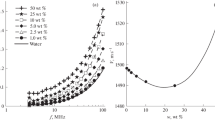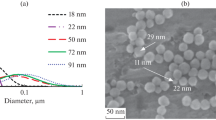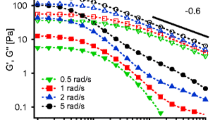Abstract
The paper presents the experimental results of an acoustic impedance study of low-frequency (105 Hz) shear elasticity of a colloidal SiO2 suspension of differently sized particles in polyethylene siloxane liquid PES-2. The agreement of the experimental results obtained by different variants of the acoustic resonance method confirms that the low-frequency shear elasticity of colloidal nanoparticle suspensions is a bulk property.
Similar content being viewed by others
Avoid common mistakes on your manuscript.
Studies [1, 2] describe the acoustic impedance method for measuring the low-frequency (105 Hz) shear elasticity of liquids. At one end of the horizontal surface of a rectangular prism of piezoelectric quartz, a layer of the studied liquid is applied, which is covered with a hard cover-plate. During tangential oscillations of the piezoelectric quartz, the liquid layer undergoes shear deformations and standing shear waves are occur. As the thickness of the liquid interlayer changes, so do the resonance frequency and resonance curve width of the piezoelectric quartz. Shifts of the resonant frequency of the piezoelectric crystal were obtained from acoustic resonance method theory [1–3]:
where G' and G" are the real and imaginary shear moduli, H is the thickness of the liquid layer, M is the mass of the piezoelectric quartz, S is the contact area between the liquid and piezoelectric quartz, and β and α are the real and imaginary components of the complex wavenumber. Figure 1 shows the theoretical dependences of the real Δf' and imaginary Δf" frequency shifts on the thickness of the liquid layer for a liquid with G'= 3 × 104 Pa and tan θ = 0.3 calculated by these formulas [1, 2].
Clearly, with an increase in the thickness of the liquid interlayer, frequency shifts yield damped oscillations. When the shear wave has completely attenuated, the frequency shifts take the limiting values \(\Delta f_{\infty }^{'}\) and \(\Delta f_{\infty }^{"}\).
From analysis of expressions (1) and (2), three methods follow for determining the low-frequency shear elasticity of liquids [1–8]. The first method is realized for small liquid layer thicknesses, when H \( \ll \) λ. In this case, the frequency shifts exhibit a linear dependence on the inverse thickness of the liquid layer 1/H. The second method is based on determination of G' from the length of the shear wave, which is determined from the attenuation maxima. The third method, similar to Mason’s well-known impedance method [9], measures the limiting values of the frequency shifts to which they tend with increasing liquid layer thickness. Since for H → ∞ the shear wave is completely attenuated, the need for the cover-plate vanishes and the entire horizontal surface of the piezoelectric quartz can be loaded with a thick layer of the studied fluid.
In this case, from expression (1) for G' it is possible to obtain the following calculation formula [1–3]:
where S is the area of the entire horizontal surface of the piezoelectric quartz. From expression (3), as well as from Fig. 1, it is clear that in the presence of shear elasticity in liquids, Δf" should be greater than Δf ′. All three methods for determining low-frequency shear elasticity were used with conventional and polymer liquids as an example, which gave quite consistent results [1–8].
Paper [10] studied the low-frequency shear elasticity of colloidal suspensions of SiO2 nanoparticles in polyethylsiloxane liquid PES-2 by the acoustic resonance method for thicknesses H much shorter than the wavelength λ. In these experiments, the layer thickness of the studied suspensions varied within a few microns. Therefore, the presence of low-frequency shear elasticity in the studied nanosuspensions can be attributed to the special properties of the boundary layers under the action of the field of surface forces.
This paper presents the experimental results of a study of shear elasticity of suspensions of SiO2 nanoparticles in PES-2 by the impedance method for H \( \gg \) λ. In the experiments, a piezoelectric quartz of X-18.5° cut was used, with a resonant frequency of 73.2 kHz, a mass of 6.82 g, and dimensions of 35 × 12 × 6 mm. Colloidal SiO2 nanosuspensions in PES-2 were obtained by prolonged dispersion using ultrasonic methods [10].
On the thoroughly cleaned horizontal surface of the piezoelectric quartz, a thick layer of the suspension was applied, in which the shear wave is completely attenuated (Fig. 2). The limiting imaginary \(\Delta f_{\infty }^{"}\) and real frequency shifts \(\Delta f_{\infty }^{'}\) were then measured. The limiting value of the real frequency shift \(\Delta f_{\infty }^{'}\) can be neglected, since its contribution is negligible, not exceeding 3% [1–3].
For the suspension studied, 0.5% by mass fraction of SiO2 nanoparticles in polyethylsiloxane liquid PES-2 with dimensions of 100 nm, the imaginary shift limit value \(\Delta f_{\infty }^{"}\) amounted to 8 Hz. Calculation according to formula (3) for the real shear modulus G' gives a value of 1.06 × 105 Pa. The results obtained for other suspensions with different sizes and concentrations c = 0.5 wt % are given in Table 1. The density of these suspensions is 0.94 g/cm3.
Comparison of the results obtained with small liquid layer thicknesses H \( \ll \) λ [10] and the results obtained by the impedance method for H \( \gg \) λ demonstrates their good agreement. This confirms that the low-frequency (105 Hz) shear elasticity of colloidal nanosuspensions is a bulk property. The low-frequency viscoelastic behavior of low-molecular-weight liquids is also discussed by other researchers [11–14].
Nanosuspensions are used in various nanotechnologies, in particular, the development of drugs, intensification of heat transfer, in of new functional materials, lubricants, paints, etc. The use of various rheological liquid media in many technological processes is responsible for the great interest in studying their mechanical properties [15–19].
REFERENCES
B. B. Badmaev, T. S. Dembelova, and B. B. Damdinov, Viscose and Elastic Properties of Polymeric Liquids (Buryat Scientific Centre of Siberian Department of RAS, Ulan-Ude, 2013) [in Russian].
B. B. Badmaev, T. S. Dembelova, B. B. Damdinov, and Ch. Zh. Gulgenov, Acoust. Phys. 63 (6), 642 (2017).
B. Badmaev, T. Dembelova, B. Damdinov, D. Makarova, and O. Budaev, Colloids Surf., A 383, 90 (2011).
U. B. Bazaron, B. V. Deryagin, and O. R. Budaev, Dokl. Akad. Nauk SSSR 205 (6), 1324 (1972).
B. B. Badmaev, B. B. Damdinov, and D. S. Sanditov, Acoust. Phys. 50 (2), 121 (2004).
B. B. Badmaev, S. A. Bal’zhinov, B. B. Damdinov, and T. S. Dembelova, Acoust. Phys. 56 (5), 640 (2010).
W. P. Mason, Piezoelectric Crystals and Their Application to Ultrasonics (D. Van Nostrand, 1950; IL, Moscow, 1952).
B. B. Badmaev, O. R. Budaev, and T. S. Dembelova, Acoust. Phys. 45 (5), 541 (1999).
B. B. Badmaev, T. S. Dembelova, B. B. Damdinov, D. N. Makarova, and E. D. Namdakova, Uch. Zap. Fiz. Fak. Mosk. Univ., No. 5, 1751302 (2017).
T. S. Dembelova, A. B. Tsyrenzhapova, D. N. Makarova, B. B. Damdinov, and B. B. Badmaev, Uch. Zap. Fiz. Fak. Mosk. Univ., No. 5, 145301 (2014).
D. Collin and P. Martinoty, Phys. A (Amsterdam, Neth.) 320, 235 (2003).
H. P. Kavehpoor and G. H. McKinley, Tribol. Lett. 17 (2), 327 (2004).
L. Noirez and P. Baroni, J. Mol. Struct. 972, 16 (2010).
L. Noirez, J. Phys.: Condens. Matter 24, 372101 (2012).
V. Ya. Rudyak, A. V. Minakov, and M. I. Pryazhnikov, Tr. Novosib. Gos. Arkhit.-Stroit. Univ. (Sibstrin) 21 (1(67)), 30 (2018).
J. Chevalier, O. Tillement, and F. Ayela, Appl. Phys. Lett. 91 (23), 233103 (2007).
N. B. Ur’ev, S. V. Emel’yanov, and K. A. Titov, Prot. Met. Phys. Chem. Surf. 51 (2), 226 (2015).
I. B. Esipov, O. M. Zozulya, and M. A. Mironov, Acoust. Phys. 60 (2), 169 (2014).
D. N. Makarova and I. B. Esipov, Vestn. Buryat. Gos. Univ. Khim. Fiz., Nos. 2–3, 45 (2018).
Author information
Authors and Affiliations
Corresponding authors
Rights and permissions
About this article
Cite this article
Makarova, D.N., Dembelova, T.S. & Badmaev, B.B. Low-Frequency Shear Elasticity of a Colloid Nanosuspension. Acoust. Phys. 66, 613–615 (2020). https://doi.org/10.1134/S1063771020050103
Received:
Revised:
Accepted:
Published:
Issue Date:
DOI: https://doi.org/10.1134/S1063771020050103






